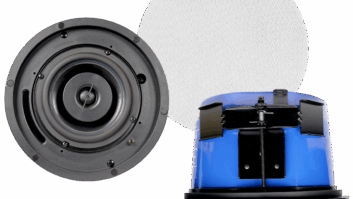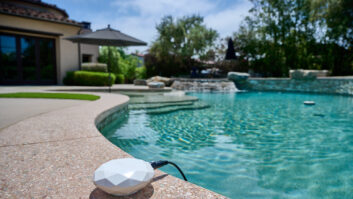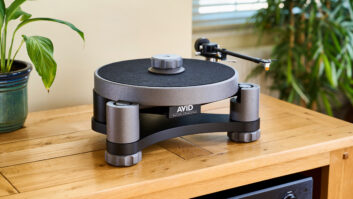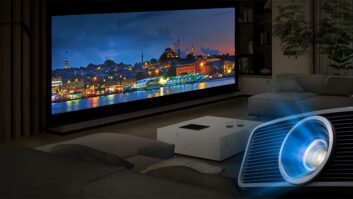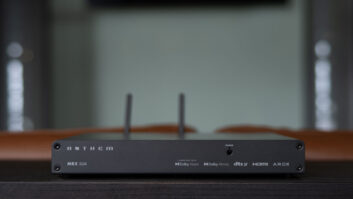Kudos: Solid build quality and cool look; easy to set up and use; reliable Bluetooth operation
Concerns: Don’t love the dust cover
Truth: I have never owned a turntable.
Well, that’s not 100 percent true. I did own a Fisher Price children’s record player that I used to play 45s that came packed in with Disney story books, but that doesn’t really count. Also, my parents never owned a turntable. When I started getting into music, it was right when Sony launched the Walkman, and that was my first conduit to audio. Then I transitioned to CDs, then I got into car stereo, and then I got a full home rig and started collecting CDs in earnest, and now the majority of my music listening is primarily streaming via Tidal.
I say that as a way of establishing a baseline for this review; I’m not going into this ensconced in that warm, fuzzy analog love-blanket knitted over years of memories associated with listening to vinyl. I’m coming into this as a complete noob, much like many of the people out there experiencing the vinyl resurgence and looking to add their first turntable.
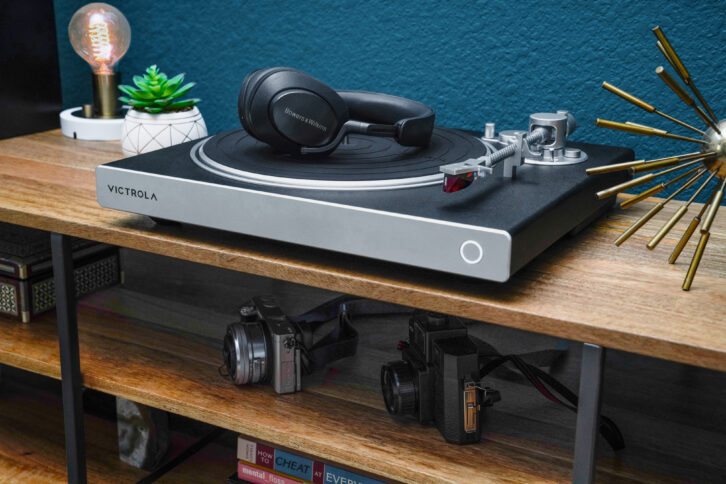
A few things excited me about the Victrola Hi-Res Carbon. First off it looked cool and well-built, with some step-up performance features, but at under $600 it is still in the budget for someone’s first deck. Second, the inclusion of Bluetooth aptX made it perfect for solo listening or for quickly pairing to a wireless speaker like a Sonos Move or Era 300 that are becoming so popular.
Victrola
According to Victrola’s website, the company has “been bringing innovation and style together since 1906.” But if you look at the Wikipedia entry for the “Victor Talking Machine Company,” they’ve been around since 1901.
Either way, Victrola has a lengthy history in turntable manufacture. And you’ll likely remember that image “His Master’s Voice,” with the dog (“Nipper”) listening to a wind-up gramophone and tilting his head, which became the trademark and logo of the Victor Talking Machine Company, and later used as the basis for an award presented by EMI records to artists for recognition of selling more than 1,000,000 recordings.
While Victrola was acquired by RCA in 1929, the modern Victrola brand is currently owned by a private equity firm “that has allowed the company to stay true to its heritage of helping people make music memories,” and there are no ties to RCA and Victrola in the U.S.
The company’s goal is to “marry the sophistication of yesterday with the technology of tomorrow,” and a glance through its online product offerings shows many retro designs.
Beyond the Hi-Res Carbon model being reviewed here, another model that will be of keen interest to the CI channel is the company’s Stream Carbon model. This unit shares many design, components, and performance specs of the Hi-Res Carbon reviewed here, but it is “Works with Sonos” certified and can be paired directly with Sonos components and control Sonos’ volume. Also, the Stream Carbon will soon be getting an update that will make it compatible with UPnP devices, as well as Roon systems.
While Victrola sells products direct-to-consumer via its website, they welcome interested CI retailers, and if you’re interested in becoming a direct dealer, you can reach out to [email protected].
Setup
While this is my first rodeo having a turntable in my system, I have actually set up a few of them for customers and at our showroom, so I wasn’t totally unfamiliar with the process. Still I appreciated — and watched! — the three-and-a-half-minute video on Victrola’s website about setting up the turntable, a process that ended up being simple and intuitive.
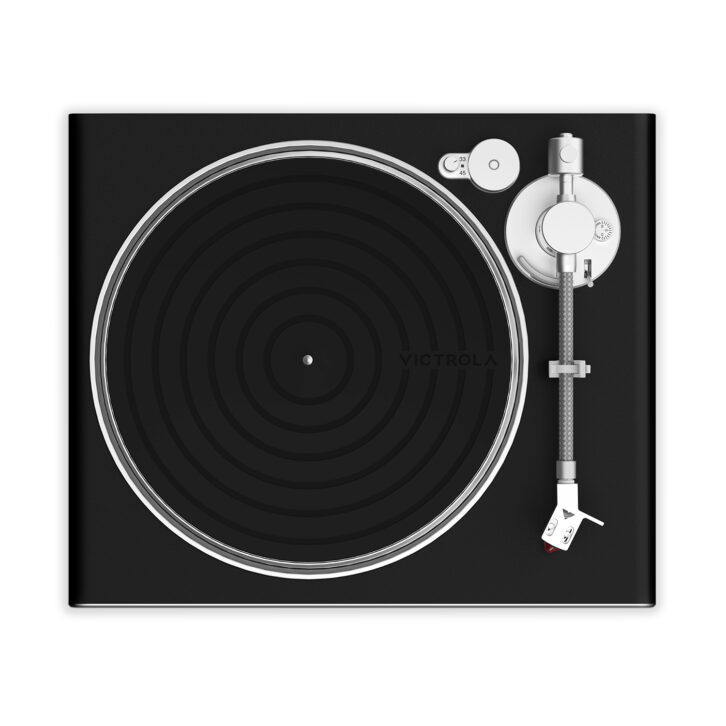
The Carbon has a modern, clean, and sleek look to it, with a brushed-aluminum front panel and black low-resonance MDF sides and top, and aluminum accented controls on top. There is a single, illuminated multi-function button on the front panel that turns the unit on/off and selects between the RCA and Bluetooth outputs.
If ultra-high-end demos at CES have taught me nothing else about turntables, I know that having a solid, stable deck and platform that isolates and eliminates any stray vibrations is a crucial starting point. While not over-the-top, the Carbon’s near-14-pound weight gives it some nice heft. It also sits on some dense rubber feet that help to stabilize the base.
As it uses a belt to turn the platter, installation involves stretching the belt over the spindle, a process that is simplified with a taped guide string. After the belt is secured, you set the silicone slipmat on top of the platter.
The “carbon” part of the turntable is the carbon fiber tonearm, which not only has a cool look, it also has better weight-to-stiffness ratio compared to aluminum, said to allow for faster and more accurate tracking, along with reduced resonance, resulting in cleaner and clearer audio reproduction.
The Carbon ships with an Ortofon 2M Red moving magnet cartridge and headshell that needs to be installed. (This cartridge alone sells separately for $99.) The headshell inserts into the tonearm and you tighten the tonearm collar until it is secure. You then slide the included counterweight onto the back of the tonearm until the front of the weight is aligned with the back groove on the tonearm, and then tighten a screw on the counterweight to lock it into place.
There are a myriad of other cartridges available — including step-ups in the Ortofon 2M line such as Blue, Bronze, and Black — and using these or any other might require different downforce and anti-skating adjustment. Victrola commented, “Typically you will notice more detail in your sound as the [cartridge] price increases, but each cartridge will have a unique sound profile as well. We’ve found that the Ortofon 2M Red provides a fantastic balance for most listeners.”
The other thing I knew about turntables is that there are two audio output levels: line and phono. A phono signal is much weaker than a line signal, typically 0.005 volts compared to 0.3 volts for a line signal, so this signal needs to be properly amplified. If your receiver has an input labeled “Phono” then it has this pre-amplifier (and RIAA equalization) built-in. If it doesn’t, then you’ll need to use an outboard phono pre-amp.
Conversely, some turntables have this pre-amp built-in, internally converting and outputting a line-level signal that works with any receiver. Smartly, the Carbon includes both, with a Line/Phono switch on the back to select your preference, allowing it to work with any system, which is good, because my Trinnov Altitude only has a single RCA analog input that only accepts line-level signals. Victrola said that if you had a high-quality system with its own phono preamp, they would recommend using that.
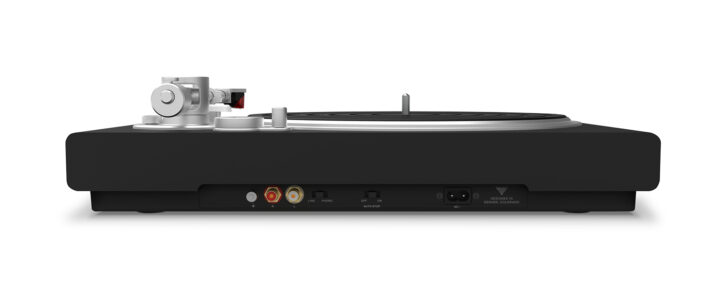
One of the Carbon’s big features is that it has integrated Bluetooth v5.4, supporting Qualcomm aptX Adaptive that can deliver up to 24-bit/96 kHz resolution. This is also backward-compatible with aptX HD and aptX codes, as well as non-aptX devices using SBC. For someone looking to assemble a simple but high-performing vinyl system, they could easily pair this deck directly with a quality pair of wireless speakers or headphones, which would be a perfect dorm room or small office solution.
On the back of the unit is an on/off switch for the platter’s Auto-stop feature. When set to On, the platter will start spinning when the tonearm hovers over the edge of the record and stop spinning when it reaches the label at the end of the record. When set to Off, it just keeps spinning when the speed selector is set to 33 or 45, regardless of tonearm position. Why someone would turn this off, I don’t know, but it’s there.
I also liked that the Carbon has detachable cables, with gold-plated RCA outputs, letting you use upgraded or different length cabling as needed. I’ve seen several decks that have permanently affixed cables, and if they get damaged, you’re forced to make a splice.
Finally, we come to my least favorite thing about the Carbon: the dust cover. This is a plastic cover that fits over the spindle and lays flat on the slipmat, with a raised section that covers the tonearm. Compared to the build quality of the rest of the unit, it just feels meh. While it does a fine job of keeping dust off the slipmat when not in use, I always wondered what to do with it when I wanted to listen to a record, kind of like Ricky Bobby in his first interview in Talladega Nights wondering what to do with his hands. Also, when in use, records are fully exposed. I was always worried my seven-year-old would accidentally grab the spinning record, or dust or something would fall on it. This cover wouldn’t be enough to make me not want the Carbon in my system, but I would have far preferred a more traditional, attached/hinged dust cover that remained part of the deck and kept the platter covered at all times.
The Vinyl Experience
Listening to vinyl is kind of a whole thing. I mean, it requires your participation at every stage. From the careful extraction of the record from its sleeve, to the obsessiveness of keeping the record clean (which is a whole ‘nother thing in itself!), to the gentle placement of the album on the platter, to the final act of dropping the needle onto the disc.
And at only 22 minutes per album side, you are almost constantly getting up to flip sides, meaning you don’t just pop on an album and then wander around the house doing something else. Vinyl practically demands active listening. In many ways, the vinyl experience reminded me of my old laserdisc days. (My CAV version of Jurassic Park spread the movie across three discs!)
Laserdiscs often came in box sets packed with supplements, and part of the fun was in exploring these extras, drawing you closer to the content in a different way. Similarly, many records come with liner notes and other extras, making it a more tactile experience, especially compared to streaming. Growing up, I can remember going through my uncle’s record collection; sitting in his closet, pulling out albums and looking at all the pictures. (Never actually listening to any of them, mind you!)
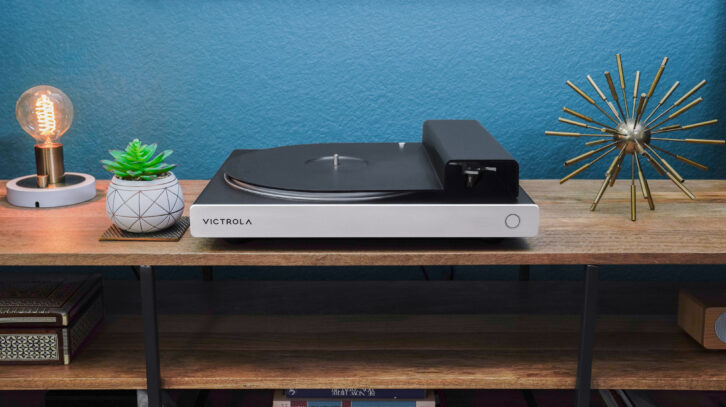
Listening to vinyl is a way of tapping into this lost music listening experience. For me, listening to the Carbon meant sitting down and really listening. Pour a glass of something, lower the lights, cue up an album, sit down, and…listen.
And there is something about the absolute analog-ness of releasing the tone arm, carefully gliding it over to the edge of the spinning record, gently lowering the tonearm down onto the record, watching it catch those first grooves and then hearing those opening crackles before the music begins.
Performance
I didn’t have a ton of vinyl available for listening, but I did have a selection of modern records my daughter had purchased (Taylor Swift and Lana Del Ray), as well as some classics (The Police, Pink Floyd, Miles Davis) at my showroom. I split my listening between the RCA outputs to my Trinnov and Bluetooth, using both Mark Levinson No5909 headphones (review available online) and some Sonos speakers.
The Carbon’s front-panel button not only turns the deck on/off, but it also toggles between RCA and Bluetooth outputs. When in RCA mode, the light is solid white, but when switched to Bluetooth mode, the Carbon immediately goes into pairing mode and the light blinks blue. I found it quickly and easily paired with any devices in the vicinity, and, following the initial pairing, it quickly reconnected with them and I never experienced any dropouts or other issues.
The one thing that is a tad confusing is that after it has paired with a Bluetooth device, the light goes back to white, so there were a couple of times when I wasn’t sure whether I was in Bluetooth or RCA output mode. I’d have preferred the light stay solid blue when it was actively transmitting.
Review: SVS Sound Prime Wireless Pro Speakers and 3000 In-Wall Subwoofer
The Bluetooth listening experience was fantastic, especially when using the Levinson No5909s. Often I am the only one in my house who wants to have music on — especially when that music is jazz — so being able to sit on the couch and enjoy an album in audiophile quality without bothering anyone was a real win all around.
The controls all felt mostly solid and well built, from the click of the 33/Off/45 speed selector to the balance and travel of the tonearm. The only thing that occasionally felt a little “splashy” was the tonearm lift lever. While it always had a nice bit of resistance when raising the arm, it was a bit loose at times when it came to lowering it, and sometimes I’d lower the lever all the way down and it would be a couple of seconds before the arm actually responded. (Usually a couple of up/down cycles brought it back.) Fortunately, even then, the arm dropped slowly and smoothly and didn’t cause any damage to the record or stylus.
Sonically, I thought the deck delivered a nice, warm, full sound. What was most apparent were the crisp, bright details like cymbal strikes, but also a rich bottom end. Listening to Kind of Blue for the umpteenth time, I could really appreciate the fine, delicate cymbal and brush work of Jimmy Cobb on “All Blues” or the strident ringing of the bells in the opening of “Time” on Dark Side of the Moon. The texture and detail in these high frequencies, along with female vocals, were certainly punctuated when listening through the Levinson headphones with their beryllium tweeters squeezing out every drop of warmth and detail.
Unfortunately, along with the headphones revealing all of the details in the music, I was also frequently reminded I was listening to a record due to the minor pops and crackles present in many quieter passages. These sounds weren’t as noticeable when listening to my tower speakers, but they were still audible. This noise was present across all the records I listened to, even though some had been played fewer than five times and had been well cared for. Even when obsessively cleaning albums between listens and immediately returning them to their sleeves when not in use, it seems the “crackles” are just part of the vinyl experience.
A lot has been said about the “vinyl resurgence,” and there are numbers to back it up. Record sales hit a 30-year high in 2022, outselling compact discs for the first time since 1987. Taylor Swift, who releases all of her new and “old” (a.k.a., “Taylor’s Version”) music on vinyl, is responsible for some of this growth, and her album Midnights was the top-selling record of 2022 by a wide margin, and 1989 Taylor’s Version will be the biggest seller (by far!) of 2023. Even still, a study found that 50 percent of those purchasing vinyl don’t actually own a turntable. This means there are a ton of potential turntable owners out there, and the Carbon Hi Res offers them a terrific option to get into the market and enjoy listening, regardless of their system!
877-483-2497; VICTROLA.COM
Specs:
- Built-in phono preamp with selectable line-level or phono-level RCA output
- Qualcomm Bluetooth v5.4 supports aptX Adaptive, aptx HD, aptX, and SBC
- Belt-drive with 33-1/3 and 45 RPM speed
- Premium carbon fiber tonearm with custom-designed removable headshell and adjustable counterweight
- Includes Ortofon 2M Red cartridge, dust cover, silicone slipmat, counterweight, 6-foot RCA cables with ground, and 45 RPM adapter
- Dimensions: 16.93 x 14.25 x 4.53-inches (W x L x D); 13.56 pounds

